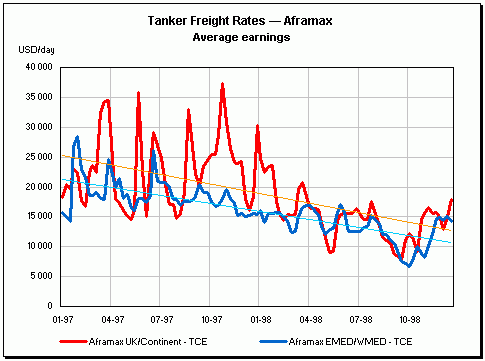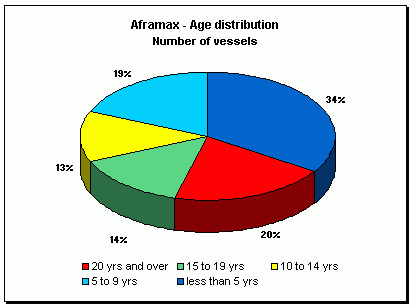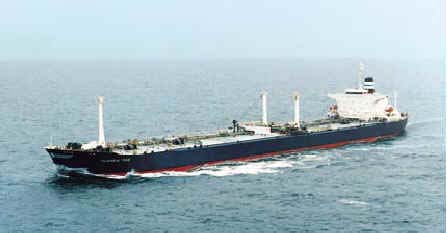
The Tanker Market in 1998
The increase in the capacities and the growing diversity of crude oil
production sites, which keep getting closer to the consumption sites, are tending to
reduce the tonne/mile ratio.
This might have been beneficial for the Aframax ships, whose
characteristics allow greater flexibility of use. However, here again, the rates and their
trend show the contrary.
This is clear proof that the period of slowdown in economic activity
that we are going through not only concerns the countries of South-Eastern Asia but is
also affecting the Western economies.

But the major factor explaining the slump in freight rates for this
category of tankers is the high surplus tonnage, the consequence of a large influx of new
ships.
| Aframax fleet on Jan 1, 1995 |
50,056,763 dwt (612 ships) |
| Aframax fleet on Nov 25, 1998 |
62,811,253 dwt (730 ships) |
Because of the good distribution of this ship category in the age
structure of the tanker fleet, scrapping is not and cannot be the only solution to the
problem.

|
| The Aframax and Panamax second-hand
market By mid-December 1998, 29 Aframax ships had
changed hands, about 20 less than in 1997. We think it interesting to emphasize the fact
that the buyers were attracted by the most modern units, since 15 of these 29 ships were
less than 10 years old and they were all sold with attached or charter back. For the most
modern ships fitted with center line bulkheads, the buyers had to obtain a back charter or
attached work in order to cover themselves against the risk related to the continuing fall
in the prices of newbuilding. The buyers of ships built at the beginning of the 1990s and
not fitted with center line bulkheads have wanted to cover and minimize their exposure on
the residual value of their purchases in the long term, which is subject to great
uncertainty. In practice, it seems to be accepted that this type of ship will not be among
the favorites of the most important charterers. In this context the following sales have
been noted: the M/T "Oriental Lady", 105,400 dwt (double hull), built in 1998
and sold for $40,000,000 against 10 years back charter at about $18,000/day; the M/T
"Sanko Protector", 96,120 dwt, single hull, built in 1993 and sold for around
$23,000,000 against five years back charter at $17,000/day. The rest of the Aframax sold,
about 14 units, were built between 1975 and 1983. The striking fact concerning these sales
is their concentration right at the beginning of the year. This can be explained partly by
the constant degradation of the freight rates, but also by the increase in the orderbook
coupled with a significant reduction in the average age of the fleet compared with the
VLCCs and the Suezmax. For information, examples include the sale in January of the M/T
"Nicolas", 88,260 dwt, built in 1981, for approximately $14,000,000 and the sale
in March of the sister ships M/T "Atlantas" and M/T "Ouranos", 87,076
dwt, built in 1975, for $4,050,000 each.
The Panamax tankers benefited from relatively high interest, since 11
units were sold during the period. It is nevertheless essential to note that no less than
six ships were bought by the same buyer, who had decided to take a predominant position in
this specific market. During the year the M/T "Anella", 60,000 dwt, built in
1986, the sister ships M/T "Neapolis" and M/T "Antipolis", 60,525 dwt,
built in 1981, the M/T "Nicopolis", 60,525 dwt, built in 1983, the M/T
"Anette", 63,098 dwt, built in 1982, and the M/T "Mantinia", 65,745
dwt, built in 1983, joined the same fleet, forming a total investment of about $95,000,000
for the buyer. Other transactions included the sale in March 1998 of the M/T "Chiba
Spirit", 60,875 dwt, built in 1980, for a price of $10,600,000, while in December the
M/T "Eastern Alliance", 60,962 dwt, built in 1983, was sold for about
$8,500,000. As for the other ship categories, the downward trend has steepened over the
months.
 |
Alandia Tide
99,958 dwt, blt 1975
owned by Alandia Tanker,
on T/C to Total©FotoFlite |
|
| The factors amplifying the crisis As discussed above, the economic crisis originating in Asia during the second
half of 1997 has overturned the often optimistic forecasts of certain experts. The
worldwide repercussions of the crisis are undeniable today.
The table below compares the trends in percentage growth rates for two
sets of countries, including forecasts for 1999/2000.
| |
1996 |
1997 |
1998 |
1999 |
2000 |
OECD
countries |
2.6 |
2.8 |
2.1 |
2.3 |
2.4 |
South-East
Asian countries |
7.6 |
6.4 |
-0.4 |
3.5 |
4.0 |
|
In view of these figures, it is easier to understand the reasons why
freight rates could hardly be maintained at such high levels as in 1997. Nevertheless, if
the forecasts turn out to be accurate, the duration of the crisis may be short.
In fact, the main amplifying factor in the present rates crisis is
attributable to the "unfortunate" combination of unfavorable economic factors
and the arrival of a large number of new ships.
However, a still greater problem is the present situation in the two
main shipbuilding countries (Japan and above all Korea). The devaluation of their
currencies against the dollar and their high production capacity (in both size and
productivity) have driven newbuilding prices into a worrying downward spiral, as shown in
the table below.
New ship price trends average prices in millions of US$
| |
1996 |
1997 |
1998 |
VLCC |
85 |
82 |
70 |
Suezmax |
52 |
51 |
45 |
Aframax |
42 |
41 |
34 |
|
Such decreases naturally attract a new influx of orders (too often
speculative, as they are not "covered" by guaranteed long-term work) which will
increase a tonnage supply which is still not offset either by sufficient demand or by
scrapping of the oldest ships.
Once again a phenomenon characteristic of the shipping world is
observed: at a time when there should be a slowdown in orders for new ships, everything is
done to encourage the shipowners and speculators to fill the orderbooks!
It is therefore logical that the values of second-hand ships depreciated
between the beginning and end of the year by more than 40% for ships built in the 1970s
and by 25% to 30% for the most modern ships. The indicators for the year to come are not
"in the green" and it is probable that the oldest ships will become increasingly
difficult to sell, unless the sellers offer particularly attractive terms. Before values
can recover, it is first necessary for the price per barrel to recover, the tonnage
supply/demand ratio to become better optimized and, above all, those involved must regain
confidence and hope. Very often we tend to believe that the elimination of the oldest
ships is the ideal solution for ending the crisis. This is certainly a fundamental
element, but it should be remembered that the oldest ships are not necessarily those in
poor condition, and that shipowners often need them in their fleet to help finance the
most modern units so requested by the charterers. We must therefore above all hope that
speculative and exaggerated newbuild orders become less common practice; here the banks
perhaps have an important role to play in preserving the value of their existing portfolio
in this way. |
| Prospects and remedies Having outlined this somewhat somber picture, it is now time to discuss, if not
the immediate solutions, at least the areas of hope that are taking shape.
As far as economic factors are concerned, all indications suggest that
the prospects for recovery are genuine and that growth in terms of energy consumption will
be observed as we move into the new millenium.
The emergence of alternative energies so desired by some is taking its
time, and everything confirms a continuing major role for oil as an energy source in the
years to come. The present situation of production overcapacity, although far from helping
the problem of the price per barrel, confirms the predominant role of oil.
As far as oil transport proper is concerned, the endemic tonnage surplus
must be given full attention, as discussed above, all the more so because the trend to
shorter routes will continue over the next few years. A particularly high proportion of
tankers (77 million dwt) will reach the "critical" age of 25 years over the
coming three years.
Although the shipowners, motivated by the high freight rates of 1997 and
the beginning of 1997, delayed the scrapping of old units, their margin of maneuver is now
becoming very small, and the various regulations in force should at last accelerate the
retirement of these ships. At this point we shall mention only three complementary
elements which should rapidly bear fruit and thus completely change the appearance of the
transport market by 2000/2001.
It should first be remembered that when a ship passes 25 years of age
its owner must obtain a fifth special survey certificate. For many of these ships which
have not previously benefited from regular and thorough upkeep policies the cost will be
prohibitive compared with the commercial prospects and above all compared with their
residual value, which is falling continuously.
International regulations are being harmonized and they too play a
decisive role in passing this notorious 25-year barrier. The MARPOL regulations stipulate
that at this age an oil tanker must be fitted with an SBT (Segregated Ballast Tanks)
system or must adopt an HBL (Hydrostatic Balance Loading) mode. Concerning HBL mode, apart
from the fact that it reduces the transport capacity (particularly for the smallest
ships), it is observed that some major charterers now purely and simply refuse to consider
this type of method.
So it is once again the more-or-less consistent attitude of the
charterers that will rationalize the basic balance of oil transport over the next two or
three years. The selection policies implemented by the oil companies are becoming
increasingly stringent and, even though the mesh of the net is still often too wide, it is
obvious that, given the low freight rates market for at least the next 12 months, a
decision to charter a ship 25 or more years old would be easy to criticize, particularly
if an incident were to occur. |
Shipping and Shipbuilding Markets 1999
I N D E X
|